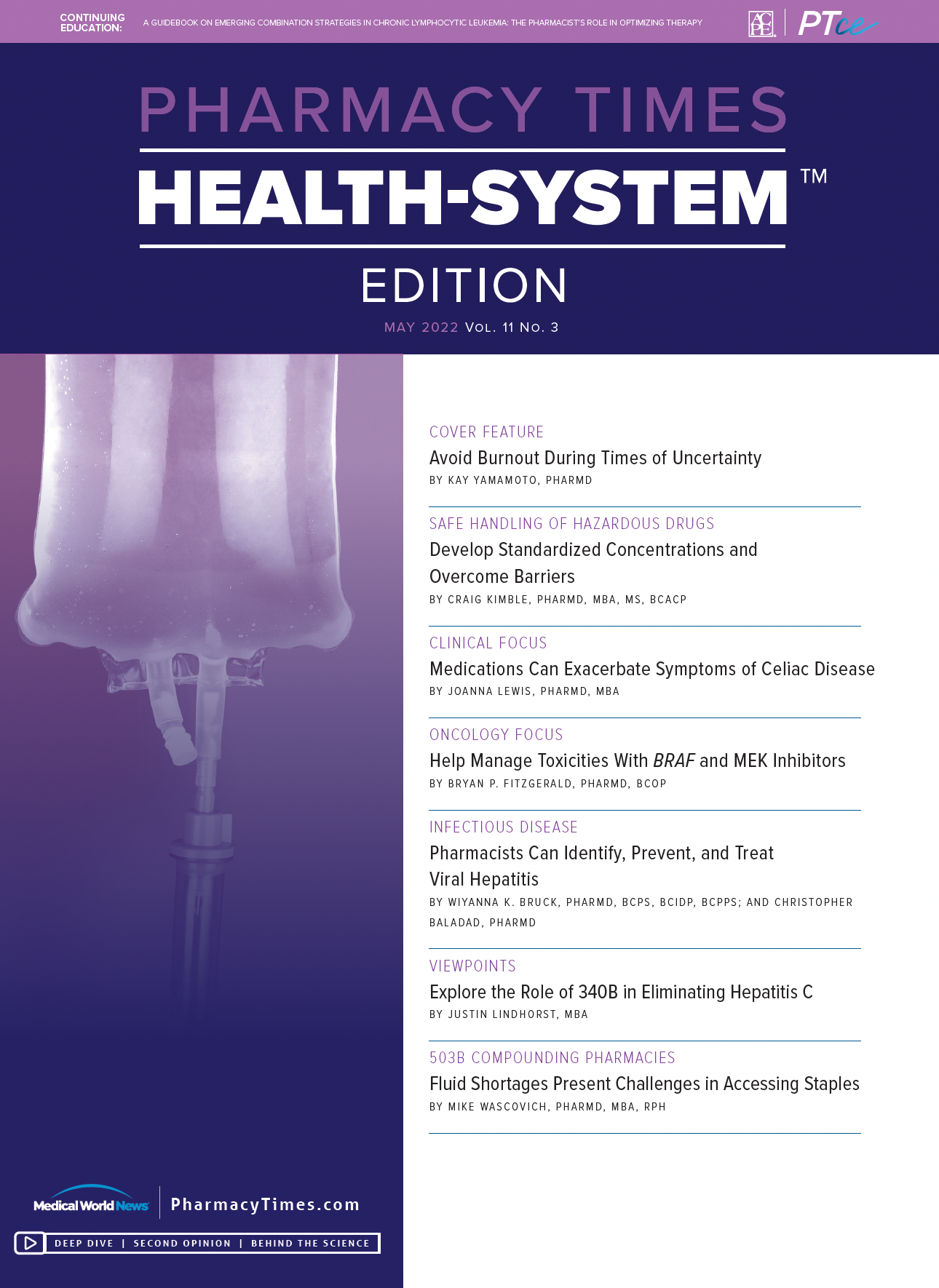Publication
Article
Pharmacy Practice in Focus: Health Systems
Develop Standardized Concentrations and Overcome Barriers
Author(s):
Simplifying processes reduces errors in compounding, IV pump programming, and physician order entry.
Past initiatives in standardizing concentrations of intravenous (IV) or liquid oral medications have focused mostly on gaining efficiency in the supply chain, improving distribution, and generating cost savings.
Improvements in medication safety with standardized concentrations were often a secondary goal of the initiatives and did not address patients moving across different care settings. Even with some standardization, many health systems still have multiple concentrations of the same drug across their own systems.1 Recent data and their promotion by the American Society of Health-System Pharmacists (ASHP), FDA, Institute for Safe Medication Practices (ISMP), and other groups show that IV admixture standardization programs can aid in reducing errors and improving transitions of care.1,2 Using concentrations that vary by location within a health system puts patients at risk of medication errors and is a concern that should be formally addressed by a national standard. Health systems must minimize the number of concentrations they keep to a maximum of 1 to 3 when possible.1 Using commercially available products is a great starting point but does not address all products. Simplifying things can reduce medication errors in compounding, IV pump programming, and physician order entry.3
Why Standardization Is Important
The ASHP, ISMP, Pediatric Pharmacy Association, and other stakeholders have long argued for a national practice standard for standardized concentrations of IV medications and oral liquid medications. The major driving factor behind these efforts is the prevention of medication errors. Errors occur with these products as patients navigate the health care system through various settings. In addition to improving patient safety, standardizing IV medication concentrations can benefit the drug supply chain with the use of premixed products, improve patient outcomes, reduce overall health care costs, and simplify ordering with fewer choices for prescribers.2,4
What Is Included
Previous attempts to standardize IV concentrations have mostly been health system– or product-specific efforts. Any standardization program initiatives should aim to address key areas in the compounding, dispensing, and administration process. These include concentrations and dosing units for continuous pediatric medications and IV continuous medications, concentrations for compounded oral liquid medications, concentrations of epidural and patient-controlled analgesia medications, IV intermittent medications; and doses for oral liquid medications. Sites should evaluate what is commercially available, adopt these products when possible, and use commercially available products as a standard across the system when feasible. Standardizing liquid doses also is key (eg, 250.0 mg vs 225.6 mg). Common drugs that are standardized in concentration include amiodarone, diltiazem, dobutamine, and dopamine.1,4
ASHP Initiative
The ASHP recently received federal funding from the FDA’s Safe Use Initiative to develop and promote a national standardized concentration initiative for IV and oral liquid medications. The Standardize 4 Safety program is a collaboration among nurses, pharmacists, physicians, and other stakeholders. Although previous efforts undertook similar initiatives at the local and state levels, this is the first funded national interdisciplinary effort to promote and standardize medication concentrations. Results so far include the development of standardized concentration lists, with additional lists expected as the program progresses.1,2 This program began looking at evidence-based standardized concentrations for 32 IV medications. The first efforts examined patients with an elevated risk of harm because of dosage errors. The goal is to reduce medication errors that occur during transitions of care.
Conclusion
It is long past time for the pharmacy profession to take the lead to establish a national standard in IV and oral liquid medication concentrations with a patient safety focus. All pharmacists have a role in promoting such efforts by participating, providing feedback, and educating others. Engaging stakeholders in their organizations with data from the ASHP Standardize 4 Safety initiative will help educate them and remove barriers. Having a national standard helps pharmacies better communicate and coordinate across health care settings to ensure consistency and patient understanding. Interdisciplinary teamwork is essential in this process, and there must be a national effort for adoption to overcome obstacles until the Standardize 4 Safety initiative is complete. To learn more about the effort or to participate, sign up for updates and resources online (https://www.ashp.org/pharmacy-practice/standardize-4-safety-initiative#s4sresources).
ABOUT THE AUTHOR
Craig Kimble, PharmD, MBA, MS, BCACP, is an associate professor of pharmacy practice, administration, and research, director of experiential learning, and manager of clinical support services at Marshall University School of Pharmacy in Huntington, West Virginia.
REFERENCES
1. Traynor K. Medication standardization effort aims to improve patient safety. American Society of Health-System Pharmacists. July 13, 2016. Accessed April 6, 2022. https://www.ashp.org/news/2016/07/13/medication_standardization_effort_aims_to_improve_patient_safety 2.
2. Standardize 4 Safety. American Society of Health-System Pharmacists. October 19, 2016. Accessed March 15, 2022. https://www.ashp.org/-/media/assets/pharmacy-practice/s4s/docs/s4s-iv-adult-continuous-infusion-guiding-principles.ashx
3. Larsen GY, Parker HB, Cash J, O’Connell M, Grant MC. Standard drug concentrations and smart-pump technology reduce continuous-medication-infusion errors in pediatric patients. Pediatrics. 2005;116(1):e21-e25. doi:10.1542/peds.2004-2452
4. ISMP achievements. Institute for Safe Medication Practices. Accessed March 16, 2022. https://www.ismp.org/about/accomplishments







